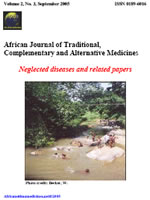
|
African Journal of Traditional, Complementary and Alternative Medicines
African Ethnomedicines Network
ISSN: 0189-6016
Vol. 15, No. 2, 2018, pp. 58-67
|
 Bioline Code: tc18030
Bioline Code: tc18030
Full paper language: English
Document type: Review Article
Document available free of charge
|
|
|
African Journal of Traditional, Complementary and Alternative Medicines, Vol. 15, No. 2, 2018, pp. 58-67
| en |
INTESTINAL HELMINTHS FROM THE VIEWPOINT OF TRADITIONAL PERSIAN MEDICINE VERSUS MODERN MEDICINE
Jazani, Arezoo Moini; Maleki, Ramin Farajpour; Kazemi, Abdol hasan; matankolaei, Leila ghasemi; Targhi, Somayyeh Taheri; kordi, Shirafkan; Rahimi-Esboei, Bahman & Azgomi, Ramin Nasimi Doost
Abstract
Background: Traditional Persian Medicine (TPM) has a history of almost 10,000 years with practice and experience aspects. The existing information and experiences of physicians such as Avicenna clearly show the vast amount of knowledge in the classification and treatment of pathogenic worms. The aim of this paper was the description of the various types of helminths along with their treatment in medieval Persia and comparing them with new medical findings.
Materials and Methods: We searched main Traditional Persian Medical and pharmacological texts about etiology, manifestation, diagnosis and treatment of worms in the human digestive system and the out come was compared with the data extracted from modern medical sources. A list of medicinal plants was also extracted from traditional pharmacological books and the anthelmintic properties of these plants were checked in Google Scholar, Scopus, PubMed and Ulrich's databases.
Results: The results show the existence of theories on pathogenicity, physiopathology, symptoms and the classification of worms in TPM. TPM philosophers have divided worms into four groups and there is not great difference between old Persian and Modern classification. The old Persian scholars have explained a treatment procedure using a list of 48 medicinal plants and the anthelmintic effect of 23 plants have been shown in modern medicine studies.
Conclusion: This study shows a more in-depth and thorough classification of pathogenic worms, their pathogenicity, symptoms and treatments in Traditional Persian Medical compared to Greek Medicine so that old Persian classification may be the base of modern taxonomy. More clinical trials are suggested for the efficacy and safety of these plants.
Keywords
Helminths; Classification; Intestinal; Traditional Medicine; Persia.
|
| |
© Copyright [2018] - African Journal of Traditional, Complementary and Alternative Medicines
Alternative site location: http://journals.sfu.ca/africanem/index.php/ajtcam
|
|
